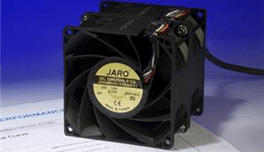Cooling Fans Break the Pressure Barrier
on

Spinning at over 19 000 rpm, a new set of counter-rotating fans from Jaro Thermal exceeds the static pressure barrier with a whopping 10 inches (H2O) of static pressure. To achieve this extraordinary force level with an air flow of 136.41 Cubic Feet per Minute (CFM), the stability, power consumption, vibration and speed of the new Super Flow Turbo Fans are all tightly monitored and controlled.
Static pressure is used to evaluate the amount of impact various ventilation system components have on the airflow path within a given system. For mechanical ventilation systems, the fans create positive static pressure to move air through a given system. All other components create negative static pressure that causes resistance to air moving through a system. A mechanical ventilation system operates with the static pressure in balance. The positive static pressure created by the fans equals the negative static pressure created by resistance as air navigates obstacles in the ventilation path.
The unit of measure for static pressure is often inches of water (in. water, H2O). The static pressure of one inch of water is the suction needed to draw water up a straw one inch. For comparison, 1 pound per square inch static pressure (1 psi) is equal to 27.7 in. water static pressure. Sometimes static pressure is given as Pascals (Pa). The static pressure of 0.1 inches of water (in. water) is equal to about 25 Pascals (Pa).*
The fixed-blade design is suitable for RAID drives, storage devices and cloud system requirements. With an operating temperature range of -10 to +70 ºC, the Super Flow Turbo Fans have a life expectancy of 70 000 hours at 40 °C and 65% relative humidity. Options include an extended operating temperature range of -25 to +90 °C, IP55 ingress protection, on-board PWM control, alarm output, tachometer output and thermistor controls.
*Source: Fans: Airflow versus Static Pressure by J. Zulovich, University of Missouri, J. P. Harner and J. F. Smith, Kansas State University and S. Pohl, South Dakota State University



Discussion (0 comments)